Contents
We go counter clockwise through the main yard starting at the front in the South-East corner, then North-East, North-West and our orchard. Finally our heart-shape bed and vegetable yard. With the exception of the vegetable yard, we use mainly shrubs and trees.
T.B.D. Add pictures of mature shrubs and trees.
Before we give some details of what we are growing on our acreage, it is important to understand the environment. We live outside of Calgary in the North-West at an elevation of 4,250 feet or 1,295 meters. Our lot measures 70 meters North-South and 120 meters East-West. On average we have frost from September 15 until May 23, which gives us a 3½ month growing season. The ground heats up pretty slow as the land predominantly slopes towards the North. Our highest point is the South-West corner where we have our picnic table for that beautiful wide view. From there it slopes down to the North and the East. The lowest point is indeed on the North side where we have a seasonal pond. An ideal place for ducks and plovers.
| Zone | Indication of hardiness, i.e. minimum winter temperatures the plant can endure: 2 -- North Alberta: -46°C to -40°C (-50°F to -40°F) 3 -- South Alberta: -40°C to -34°C (-40°F to -30°F) 4 -- further South: -34°C to -28°C (-30°F to -20°F) |
| Height, spread | Approximate maximum size under ideal conditions. |
| Divide | Indication of how many years after planting the perennial should be divided: A -- large perennials, use shovel, about three stems per piece with lots of roots B -- small perennials, use knife, at least one growing point with some roots C -- easily separated perennials, pull apart, must have own stem and roots |
Click on a picture for an enlargement and use the "back" button of the browser to return to this page.

area: South-East
topography: level
sun: whole day
soil: poor, dry
Mainly grass with beds of roses and lilacs. In the far corner young Colorado Spruce, and along the driveway Double Flowering Plum. In July 2005 a young Burr Oak is planted between the Lilacs and the Plums; should be a sight in 20 or 30 years from now.
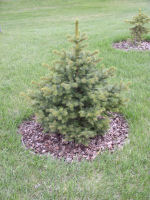
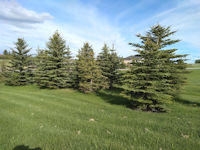
Colorado Spruce (evergreen)
(Picea pungens 'Glauca')
zone: 2
height: 12 m, 40 ft
spread: 4.5 m, 15 ft
foliage: green to blue
Pyramidal evergreen, planted as seedlings, and are after 6 years about 125 cm (4 ft) tall. Put together in the far corner as a group of 17.
Second picture taken in June 2020.
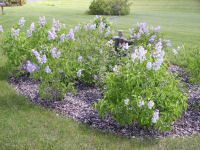
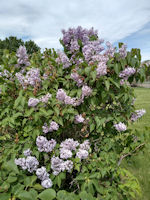
Common Lilac, Miss Canada Preston Lilac (shrub)
(Syringa vulgaris, Syringa prestoniae 'Miss Canada')
zone: 2/3
height: 3 m, 10 ft
spread: 2.5 m, 8 ft
flower: mauve to white, fragrant
This flowerbed contains 10 Lilacs. They have been struggling as the soil is pure clay, but finally after 6 years and a wet summer they are coming around. Fertilize with bonemeal in fall to promote flowering next spring. Notice our garden Pinocchio made from ordinary fence posts.
Last picture taken June 2020.
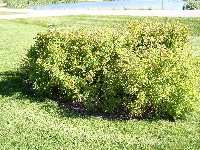
Hedge Rose (rose)
(Rosa woodsii)
zone:
height: 1.5 m, 5 ft
spread: 1.5 m, 5 ft
flower: small, single, pink
We have 4 flowerbeds with these roses along the East side of our property. These Hedge Roses have a tendency to sucker, which is fine with us as it fills up the flowerbed. In late summer the flowers make place for the rose bottles.
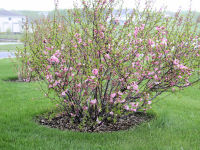
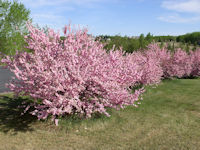
Double Flowering Plum (shrub)
(Prunus tribola 'Multiplex')
zone: 2
height: 2.5 m, 8 ft
spread: 3 m, 10 ft
flower: pink, double
pruning: rigorously after blooming to promote new growth for next year
10 of these Double Flowering Plums line the South side of our driveway. Pruning is very important as flowers are formed in early spring on wood that grew the year before.
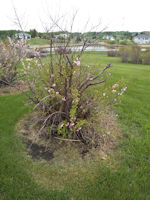
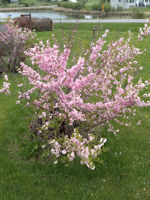
June 2020; pruning is essential.
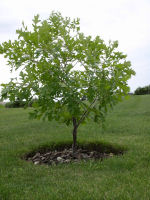
Burr Oak (tree)
(Quercus macrocarpa)
zone: 3
height: 10 m, 33 ft
spread: 10 m, 33 ft
Large lobed leaves, corky bark and large acorns. This oak is of the hardy variety and drought resistant.
Click on a picture for an enlargement and use the "back" button of the browser to return to this page.
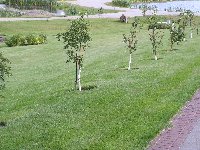
area: North-East
topography: level
sun: whole day
soil: poor, moist
Mainly grass with a bed of Dogwood to hide a transformer in the far corner. Around the seasonal pond are beds of Elder and Cotoneaster, and various trees to give the pond more definition. Mountain Ash line the driveway on the North side.
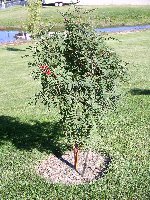
American Mountain Ash, Showy Mountain Ash (tree)
(Sorbus Americana, Sorbus Decora)
zone: 2
height: 6 m, 20 ft
spread: 5 m, 17 ft
flower: white, scarlet
fruit: red berries in fall
foliage: orange in fall
These Mountain Ash line the North side of the driveway. Cedar Waxwings love the berries. Problem is that deer love the leaves.
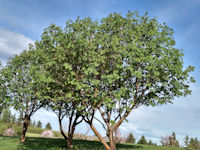
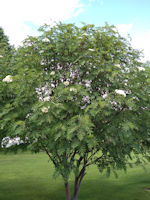
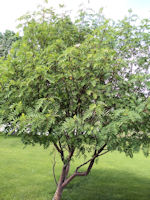
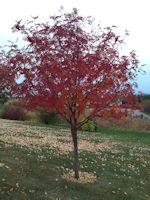
The first three pictures are taken in June 2020, and the last one in October 2020.

Hedge Rose (rose)
(Rosa woodsii)
zone:
height: 1.5 m, 5 ft
spread: 1.5 m, 5 ft
flower: small, single, pink
We have 4 flowerbeds with these roses along the East side of our property. These Hedge Roses have a tendency to sucker, which is fine with us as it fills up the flowerbed. In late summer the flowers make place for the rose bottles.
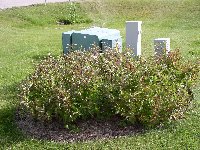
Red-Osier Dogwood (shrub)
(Cornus stolonifera)
zone: 3
height: 2 m, 7 ft
spread: 1.5 m, 5 ft
flower: white cluster
fruit: ice blueish
Features blood-red stems which is very decorative in winter. Foliage has burgundy-red fall colour.
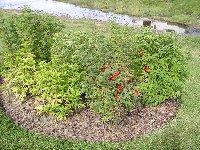
Red Elder, Golden Elder (shrub)
(Sambucus racemosa 'Pubens', Sambucus canadensis 'Aurea')
zone: 3
height: 2.5-3 m, 8-10 ft
spread: 2-2.5 m, 7-8 ft
flower: white cluster
fruit: red, golden
Likes moisture. Takes several years to get going.
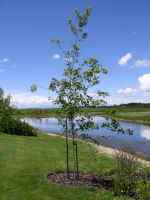
Sienna Glen Maple (tree)
(Acer x Freemanii 'Sienna Glen')
zone: 3
height: 19 m, 63 ft
spread: 10 m, 33 ft
foliage: will turn yellow-orange in fall
We have been looking for years for a maple suitable for our area and soil conditions. We planted this one in Jun-2007 and will see how it goes.
In the 2007/2008 winter it lost everything above 1 meter due to winter kill, and in the 2008/2009 winter it lost all branches again due to winter kill. The maple tree is now less than 1 meter high.
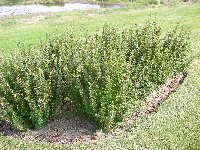
Cotoneaster (shrub)
(Cotoneaster acutifolia)
zone: 2
height: 2 m, 7 ft
spread: 1.5 m, 5 ft
flower: pink
fruit: dark
foliage: red in fall
A very reliable base shrub. We would have preferred the cotoneaster horizontalis because of its bright scarlet berries, but we haven't been able to find those.
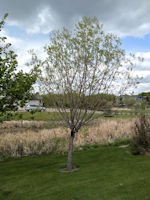
Laurel Leaf Willow (tree)
(Salix pentandra)
zone: 3
height: 13 m, 43 ft
spread: 9 m, 30 ft
flower: fuzzy yellow pendulous catkins
foliage: shiny green foliage, golden yellow in fall
Likes a moist location therefore it is close to the pond.
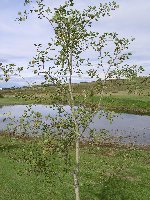
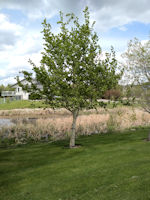
Quaking (trembling) Aspen (tree)
(Populus tremuloides)
zone: 2
height: 20 m, 66 ft
spread: 10 m, 33 ft
flower: catkins
foliage: not very dense
The leaves makes a very pleasant trembling sound when the wind moves through them, hence the name "quaking". produces cotton fluff.
Last picture taken in June 2020.
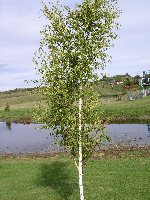
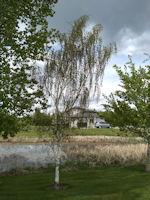
Cutleaf Weeping Birch (tree)
(Betula pendula 'Youngii')
zone: 3
height: 3 m, 10 ft
spread: 4 m, 13 ft
flower: catkins
foliage: not very dense
Takes a few years before it is established. Loves water, hence we have it next to the pond. Bark whitens with age.
Last picture taken in June 2020
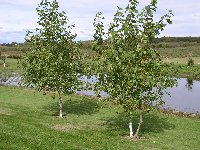
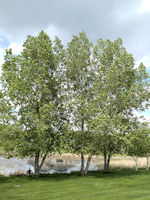
Poplar Brooks #6 (tree)
(Populus 'Brooks #6')
zone: 2
height: 15 m, 50 ft
spread: 12 m, 40 ft
flower: catkins
foliage: very dense, large leaves
The Brook #6 is non-suckering, fast growing tree. Right now (2020) they have thick trunks and are taller than the top of our house.
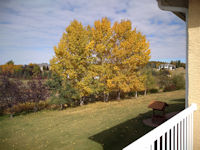
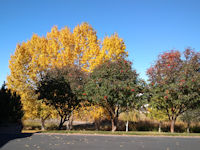
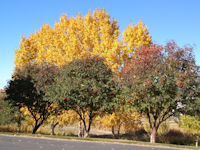
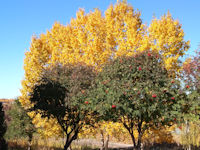
These pictures were taken in September and October 2020.
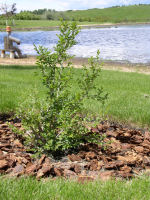
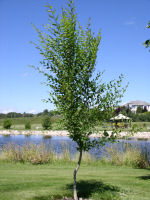
Siberian Elm (tree)
(Ulmus pumila)
zone: 2
height: 15 m, 50 ft
spread: 11 m, 16 ft
foliage: small, green leaves, yellow in fall
Fast growing spreading tree with fine branching. Brittle wood breaks easily, which could be a problem in open land and when ice forms on its branches in the winter. We planted it Jun-2007 and will see how it does. Right now it looks a bit small next to the 6 meter (20 feet) tall poplars.
We would have loved to plant an American Elm, but we settled for the Siberian Elm as it is resistant to Dutch elm disease. However, play it safe, and prune dead/sick branches immediately and destroy. Also pull seedlings unless you like to start a nursery.
The second picture shows what the elm looks like in August 2009.
Click on a picture for an enlargement and use the "back" button of the browser to return to this page.
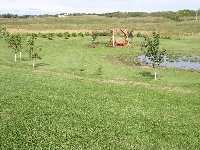
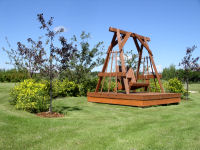
area: North-West
topography: level
sun: whole day
soil: good, moist
Mainly grass with more trees around the seasonal pond and our "senior" swing. Further a bed with Dogwood and Silver Buffalo Berry, and in the far corner young Colorado Spruce. Along the whole West side of the property a hedge of yellow Potentilla.
The second picture is a close-up of the senior-swing showing what it looks like in August 2009.
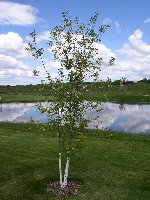
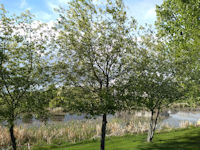
Shubert Chokecherry (tree)
(Prunus virginiana 'Shubert')
zone: 3
height: 4.5 m, 15 ft
spread: 3 m, 10 ft
flower: white, fragrant
fruit: black cherries
foliage: new leaves are green and then mature purple
Excellent ornamental accent tree.
Second picture taken in June 2020.
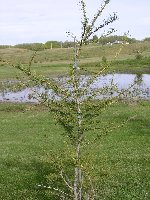
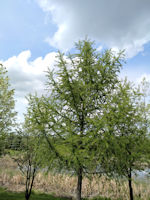
Siberian Larch (evergreen)
(Larix siberica)
zone: 2
height: 8 m, 25 ft
spread: 3.5 m, 12 ft
foliage: turn bright yellow in fall; water regularly
A unique deciduous conifer that sheds its soft clusters of needles in winter. Likes a moist place.
Second picture taken in June 2020.
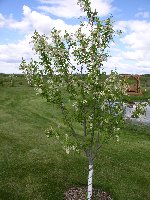
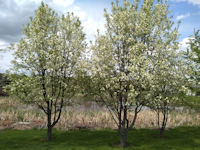
May Day (tree)
(Prunus padus commutata)
zone: 3
height: 6 m, 20 ft
spread: 4.5 m, 15 ft
flower: showy white fragrant
fruit: black, bitter
The fruits attract birds. In spring 2015 a May Day started growing towards the front; most likely from a seed dispersed by birds.
Second picture taken in June 2020.
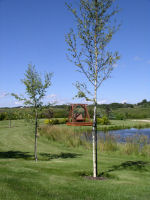
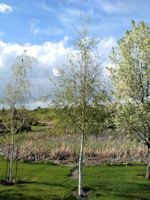
Cutleaf Weeping Birch (tree)
(Betula pendula 'Youngii')
zone: 3
height: 3 m, 10 ft
spread: 4 m, 13 ft
flower: catkins
foliage: not very dense
Takes a few years before it is established. Loves water, hence we have it next to the pond. Bark whitens with age.
Last picture taken in June 2020.
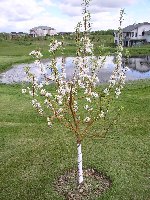
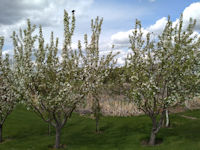
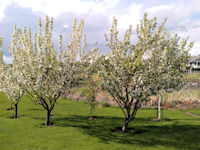
Dolgo Crapapple (tree)
(Malus x 'Dolgo')
zone: 2
height: 5 m, 16 ft
spread: 3 m, 10 ft
flower: white
fruit: red, edible
Requires proper pruning to shape the tree. The fruits are excellent for jelly.
Last two pictures taken in Junw 2020.
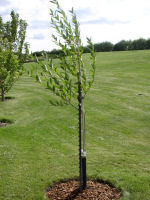
Laurel Leaf Willow (tree)
(Salix pentandra)
zone: 3
height: 13 m, 43 ft
spread: 9 m, 30 ft
flower: fuzzy yellow pendulous catkins
foliage: shiny green foliage, golden yellow in fall
Likes a moist location therefore it is close to the pond.
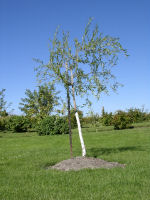

Chinese Weeping Willow (tree)
(Salix babylonica)
zone: 2 (??? others say suitable for zone 4 ???)
height: 12 m, 40 ft
spread: 9 m, 30 ft
Ideal for a big yard, close to a pond or stream. Those weeping branches, almost touching the ground, appear to be inviting you, "Please come under my branches, I will protect you." Planted in 2006 and survived the mild 2006/2007 winter. Area around the tree is constantly flooded.
In the winter of 2007/2008 the willow lost all its branches due to frost; basically reducing it to half its original height. After the 2008/2009 winter the willow lost again all its branches due to winter kill, and now looks like the second picture (August 2009), and that height is very handy for the deer to nibble on the tender leaves. If you like a shrub then plant a tree!!!
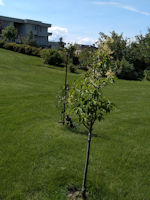
Ivory Silk Lilac (tree)
(Syringa reticulata 'Ivory Silk')
zone: 3
height: 7.5 m, 24 ft
spread: 4.5 m, 14 ft
flower: ivory colour
Foliage: dark green
Requirs full sunlight. It prefers to grow in average to moist conditions, and shouldn't be allowed to dry out.
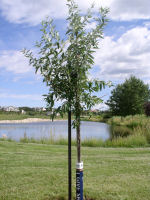
Russian Olive (tree)
(Elaeagnus angustifolia)
zone: 3
height: 8 m, 27 ft
spread: 8 m, 27 ft
flower: small fragrant yellow flower
Foliage: silver
A drought tolerant tree once established, but there is not much need for that as it is planted close to the pond.
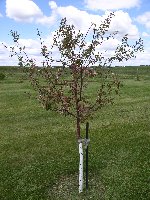
Makamik Crapapple, Royalty Flowering Crabapple (tree)
zone: 2
height: 8 m, 27 ft
spread: 3 m, 10 ft
flower: pink, reddish purple
foliage: purple leaves, orange in fall
fruit: purple
Requires proper pruning to shape the tree.
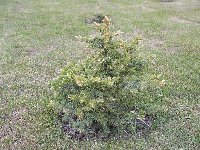
Colorado Spruce (evergreen)
(Picea pungens 'Glauca')
zone: 2
height: 12 m, 40 ft
spread: 4.5 m, 15 ft
foliage: green to blue
Pyramidal evergreen, planted as seedlings, and are after 6 years only about 50 cm (2 ft) tall due to the open exposure to the North-West dry wind in the winter. Put together in the far corner as a group of 12.
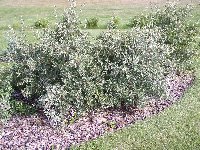
Silver Buffaloberry (shrub)
(Shepherdia argentea)
zone: 2
height: 3.5 m, 11 ft
spread: 3.5 m, 11 ft
flower: yellow on female plants
fruit: red berries
Drought resistant, spiny shrub. Takes a while to establish. This plant is covered with sharp thorns that can make it difficult to harvest the fruit, and to do maintenance around the shurbs
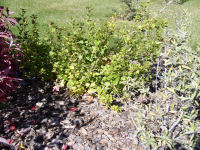
Alpine Currant (shrub)
(Ribes Alpine)
zone: 2
height: 1.5 m, 5 ft
spread: 1.5 m, 5 ft
flower: yellow
The Alpine Currants got overtaken bij the dogwood and the silver buffalo berries.

Red-Osier Dogwood (shrub)
(Cornus stolonifera)
zone: 3
height: 2 m, 7 ft
spread: 1.5 m, 5 ft
flower: white cluster
fruit: ice blueish
Features blood-red stems which is very decorative in winter. Foliage has burgundy-red fall colour.
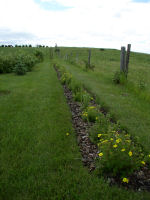
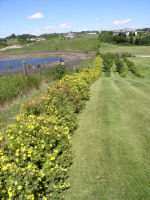
Potentilla Goldfinger (shrub)
(Potentilla fruticosa 'Goldfinger')
zone: 2
height: 1.25 m, 4 ft
spread: 1 m, 3 ft
flower: dark yellow
Very hardy potentilla with the largest flowers. Encourage new growth by vigorous pruning in early spring. We planted (in fall 2003) some 130 potentillas (from seed) to create a hedge along the West side of our property. We also planted 20 potentillas between the Makamik Crabapple trees around the two-seater swing in 2004. First picture shows the hedge viewing from the North in 2005, while the second picture shows the hedge from the South in August 2009.
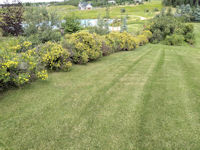
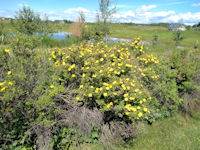
Pictures taken in Augustus 2020. Its is very clear that lots of pruning still needs to be done.
Click on a picture for an enlargement and use the "back" button of the browser to return to this page.
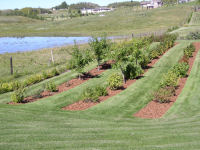
area: Orchard, West
topography: level
sun: whole day
soil: good, moist
Mainly grass with three rows of fruit trees and shrubs. Here an late summer picture.
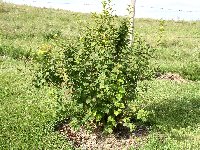
Nanking Cherry (shrub)
(Prunus tomentosa)
zone: 2
height: 2 m, 6 ft
spread: 2 m, 6 ft
flower: light pink
fruit: red cherry, edible
We have them since 1968, they flower, but I still have to see the first cherry. Supposedly the cherries are great for jelly.
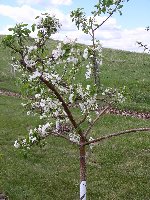
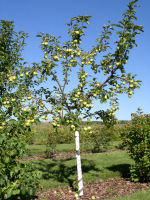
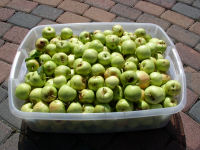
Heyer #12 Apple (tree)
(Malus 'Heyer #12')
zone: 3
height: 6 m, 20 ft
spread: 5 m, 17 ft
flower: white
fruit: 2" to 2½" yellow-green fruit in late August
Although the fruit can be eaten fresh, making apple sauce from it is a much better way of using these tart apples. In 2006 we had our best year. We picked 69 kg (152 lbs) from four trees, and converted all of the fruits into apple sauce and apple pies. The container shows what we picked from just one tree.
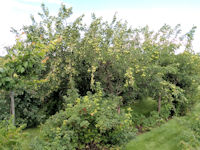
This picture taken in August 2020 after a moose had its fill on the left side.
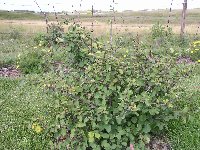
Smokey Saskatoon, Pembina Saskatoon, Northline Saskatoon (shrub)
(Amelanchier alniflora 'Smokey', Amelanchier alniflora 'Pembina', Amelanchier alniflora 'Northline')
zone: 2/3
height: 3 m, 10 ft
spread: 2 m, 7 ft
fruit: Smokey: purplish/blue berries; Pembina: sweet, mild-flavoured fruit; Northline: large berry with wonderful saskatoon flavour
Good for eating fresh, or for pies and jams.
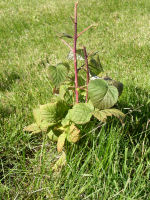
Black Raspberry Jewel, or Blackberry (shrub)
(Rubus spp.)
zone:
height:
spread:
fruit: deep purple
Sensitive to winter kill which is a problem as fruit develops on previous year growth. Every year one or two shrubs show up. Covering the plants for next year does not work either.
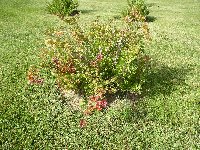
Dakota Gooseberry (shrub)
(Ribes spp.)
zone:
height:
spread:
fruit: tard, small, yellowish fruit
Not very good for eating fresh. In addition an insect lays eggs in the fruits which start rotting. As we grow our food organic we have lost our gooseberries, red currants and black currants.
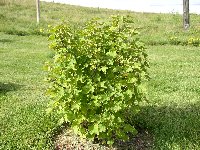
Red Currant (shrub)
(Ribes 'Redlake')
zone: 3
height: 1 m, 3 ft
spread: 1 m, 3 ft
fruit: small red fruit, a bit tart
Can be eaten fresh or made into jams. Sensitive to winter kill which is a problem as fruit develops on old growth. In addition an insect lays eggs in the fruits which start rotting. As we grow our food organic we have lost our gooseberries, red currants and black currants.
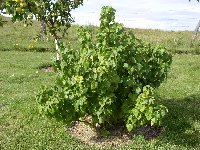
Black Currant (shrub)
(Ribes nigrum)
zone: 3
height: 1 m, 3 ft
spread: 1 m, 3 ft
fruit: small black fruit, very tart
Suitable for jams. Sensitive to winter kill which is a problem as fruit develops on old growth. In addition an insect lays eggs in the fruits which start rotting. As we grow our food organic we have lost our gooseberries, red currants and black currants.
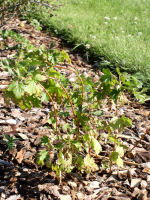
Buffalo Currant (shrub)
(Ribes odoratum)
zone: 2
height: 1.2 m, 4 ft
spread: 1 m, 3 ft
fruit: large black currants in the late summer
Excellent for jams, juice, syrups and wine. The foliage is light green which turns yellow/orange in autumn. Will grow well in full sun or shade and is tolerant of dryer soils. The flowers smell like cloves.
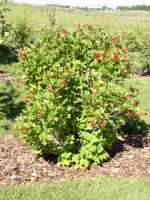
Rabbit Hill Cranberry (shrub)
(Viburnum 'Rabbit Hill')
zone:
height: 2 m, 7 ft
spread: 2 m, 7 ft
fruit: tart red fruit
Excellent for jelly. It took a while until the shrub was mature enough to have berries, but we found the berries too tart to justify harvesting them.
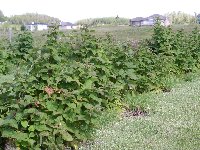
Raspberry Boyne (shrub)
(Rubus 'Boyne')
zone: 3
height: 1.5 m, 5 ft
spread: 1.5 m, 5 ft
fruit: Sweet, red fruit
Good for eating fresh. Sensitive to winter kill which is a problem as fruit develops on previous year growth. Does sucker.
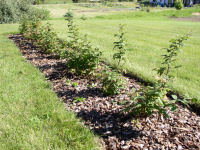
Raspberry Primocane (shrub)
(Rubus 'Primocane')
zone: 3
height: 1.5 m, 5 ft
spread: 30 cm, 1 ft
fruit: Sweet, red fruit
Good for eating fresh. These raspberries are also a hardy variety for the prairies. These raspberries do not require thinning or pruning. They can be mown down every year to within a couple of inches, but we prefer to cut ours down every 2 or 3 years to clean up the patch. Fruits mid summer through fall. Does sucker.
Click on a picture for an enlargement and use the "back" button of the browser to return to this page.
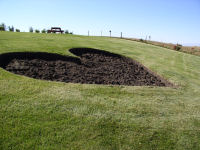
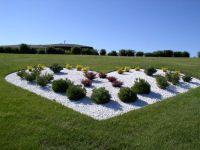
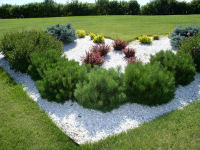
area: 32 m² (348 sqft)
topography: North sloping
sun: whole day
soil: very good, dry
The first picture was taken in 2004 after the sods were taken off and a foot of clay had been removed from underneath the good soil. After the winter 15 cubic yard (11-1/2 m3) of garden mix was added. This new bed was completed in June 2005, planted with various coloured shrubs, covered with landscaping fabric and with crystal white rocks on top.
Have a good look at the second picture. Do you see the smiling face: blonde eyebrows, blue-grey eyes, red nose, pinkish cheeks and a smiling mouth with teeth?
The third picture shows what it looks like in August 2009.
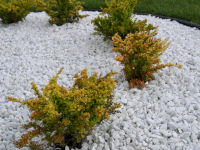
Sunsation Barberry (shrub)
(Berberis thunbergii 'Monry')
zone: 3/4
height: 1 m, 3 ft
spread: 1 m, 3 ft
foliage: golden-yellow
The eyebrows. Here in the picture the shrubs look very good, but every year they got smaller and smaller, so eventually we transplanted to another South facing area. But no success there either.
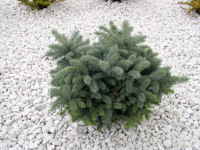
Spruce Blue Globe (evergreen)
(Picea pungens 'Glauca Globosa')
zone: 2
height: 1.5 m, 5 ft
spread: 1.5 m, 5 ft
foliage: blue
The eyes. Prune in spring to maintain a globe form. These did very well. Obviously the smiley face cannot be seen anymore.
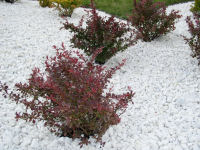
Cherry Bomb Japanese Barberry (shrub)
(Berberis thunbergii 'Cherry Bomb')
zone: 3/4
height: 1 m, 3 ft
spread: 1 m, 3 ft
foliage: deep crimson
The nose. Here in the picture the shrubs look very good, but every year they got smaller and smaller, so eventually we transplanted to another South facing area. But no success there either.
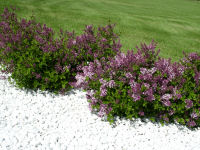
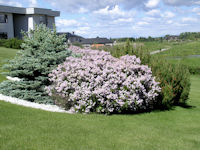
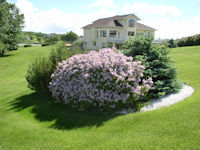
Dwarf Korean Lilac (shrub)
(Syringa meyeri 'Palibin')
zone: 3
height: 1.5 m, 5 ft
spread: 1.5 m, 5 ft
flower: lavender, fragrant
The cheeks. These did very well. Obviously the smiley face cannot be seen anymore.
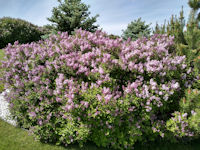
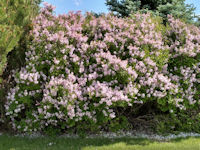
Pictures taken in July 2020.
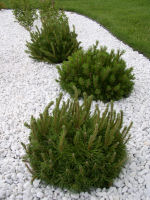
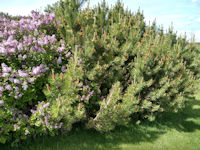
Mugho Pine (evergreen)
(Pinus mugo)
zone: 2
height: 2 m, 7 ft
spread: 2 m, 7 ft
The mouth. Takes about 15 years to mature. Trim 1/3 of the buds for a compacter growth. These did very well. Obviously the smiley face cannot be seen anymore.
Click on a picture for an enlargement and use the "back" button of the browser to return to this page.
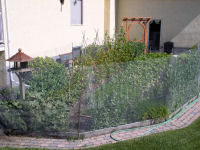
area: 48 m² (517 sqft)
topography: level
sun: until early evening
soil: very good
Our annual supply of fresh vegetables for the summer and for in the freezer for the winter. Normally no fertilizers and no pesticides (herbicides, insecticides); just some compost, some water and some tender love and care. This year (2006) we use for the first time a bit of 8-12-6 fertilizer from PINK. We have three long beds of about 50" wide, separated by two paths. The whole is surrounded by chicken wire to keep gophers (Richardson Ground squirrel) and deer out.
The 2006 crop was: broad bean (Broad Windsor), pole bean (Scarlet Runner & Smeraldo), radish (Cherry Bell), spinach (Long Standing Bloomsdale), Swiss chard (Rhubarb), Pea (Snowpea Snowflake), rhubarb (perennial), strawberry (Eversweet, Kent & Seascape -- perennials), bush bean (Stringless Green Pod), red beet (Detroit Dark Red), carrot (Scarlet Nantes), pea (Alaska), lettuce (Red Butterworth & Early Curled Simpson), endive (Green Curled Ruffec), and onion (Annual Bunching).
The 2007 crop was: broad bean (Broad Windsor), pole bean (Scarlet Runner & Romano), radish (Cherry Bell), spinach (Long Standing Bloomsdale), Swiss chard (Rhubarb), Pea (Snowpea Snowflake), rhubarb (perennial), strawberry (Eversweet, Kent & Seascape -- perennials), bush bean (Stringless Green Pod), red beet (Detroit Dark Red), carrot (Scarlet Nantes), common green purslane (Portulaca oleracea), pea (Alaska), lettuce (Grand Rapids & Early Curled Simpson), endive (Full Heart Batavian), and Brussels Chicory (Cichorium intybus; a two-step growing process).
The 2008 crop is: pole bean (Scarlet Runner & Romano), radish (Cherry Bell), spinach (Long Standing Bloomsdale), Swiss chard (Rhubarb), Pea (Snowpea Snowflake), rhubarb (perennial), strawberry (Eversweet, Kent & Seascape -- perennials), bush bean (Stringless Green Pod), red beet (Detroit Dark Red), carrot (Scarlet Nantes), common green purslane (Portulaca oleracea), pea (Alaska), lettuce (Grand Rapids & Early Curled Simpson), endive (Full Heart Batavian), and Brussels Chicory (Cichorium intybus; a two-step growing process).
We do our best to rotate the crop between the beds in a three year cycle.
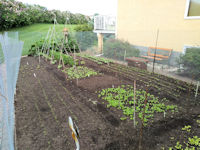
The 2020 crop was: lettuce (Early Curled Simpson), Carrot (Scarlet Nantes), Swiss chard (Rhubarb), chicory Mechelse middelvroeg (Cichorium intybus), lettuce (Buttercrunch), endive (Full Heart Batavian), pole/slice beans (Scarlet Runner), rhubarb (perennial), red beet (Detroit Dark Red), bush beans (Stringless Green Pod). The picture was taken the end of June 2020.
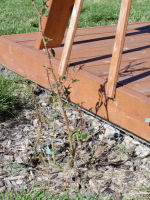
Rosa Explorer 'John Cabot' (rose)
Rosa Explorer 'John Cabot'
zone: 3
height: 2.5 m, 8 ft
spread: 1.5 m, 5 ft
flower: pink, double, strong fragrance
Requires trellis or other support. We transplanted (Jun-2007) these roses from the swing in the Northwest part of the yard to our more sheltered vegetable yard next to the garden gate. Disease resistant.
Homepage |
Grand Tour |
Main Yard Details |
Flowerbed Details |
Yard Tips |
Wildlife |
Animal Terminology |
Other Web Sites